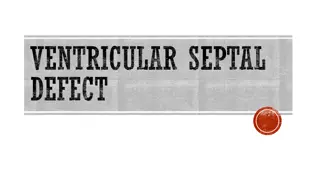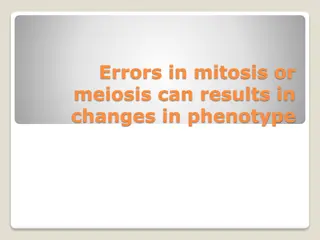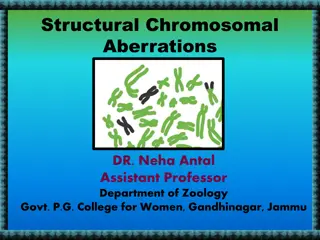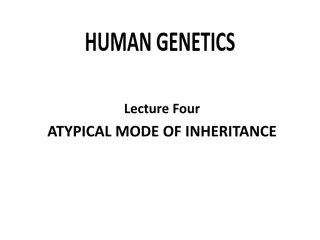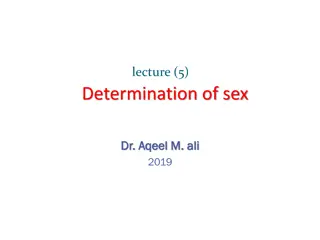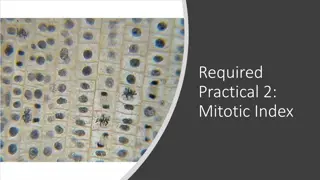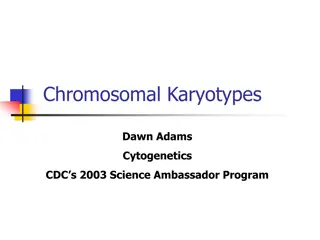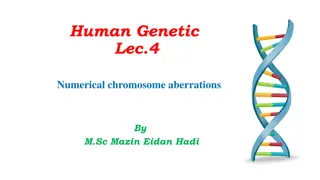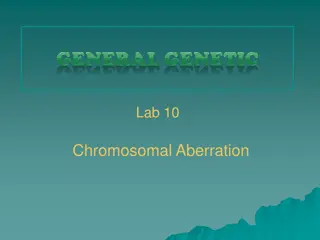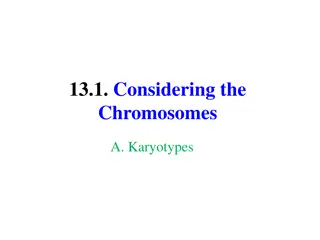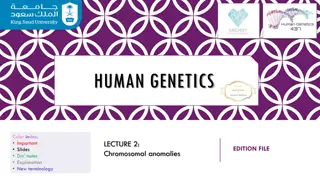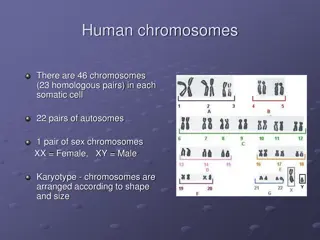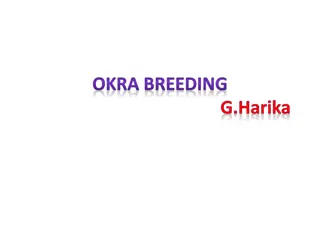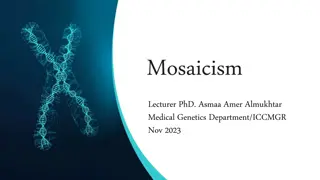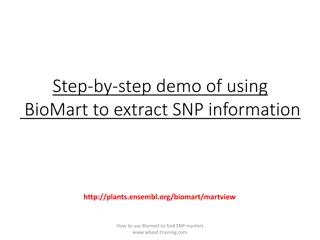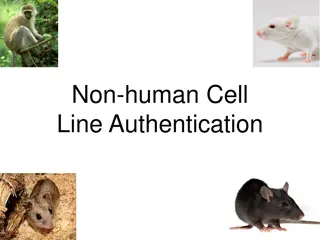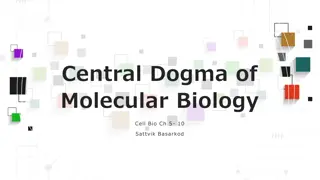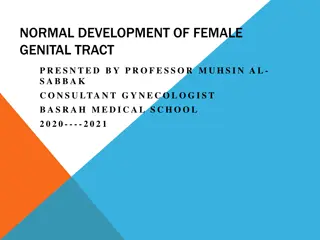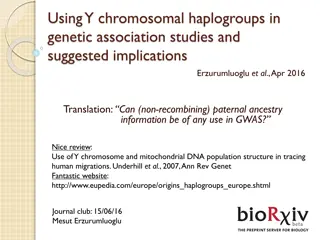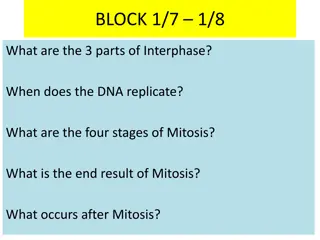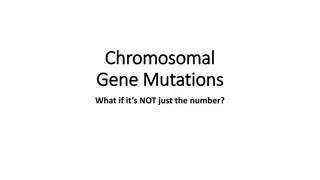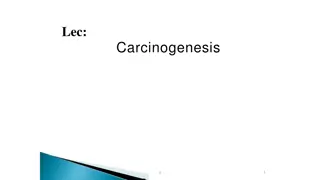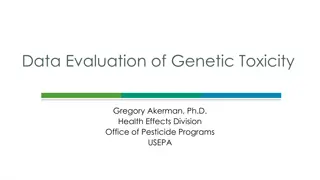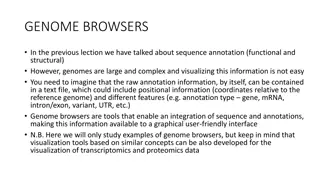Understanding Ventricular Septal Defect (VSD) and Treatment Options
Ventricular Septal Defect (VSD) is a common congenital heart condition characterized by a hole in the septum between the heart's ventricles. This defect can lead to various complications and is often associated with chromosomal disorders. Different types of VSD exist, each requiring tailored treatme
6 views • 72 slides
Chromosomal Alterations and Their Impact on Phenotype
Errors in mitosis or meiosis can result in changes in phenotype, often due to alterations in chromosome structure such as deletion, duplication, inversion, and translocation. Nondisjunction can lead to abnormal chromosome number, resulting in disorders like aneuploidy. Polyploidy, with extra complet
0 views • 9 slides
Understanding Structural Chromosomal Aberrations and Their Impact on Genetic Information
Chromosomal aberrations involve significant changes in chromosome structure and number, impacting multiple genes. These mutations can be structural or numerical, resulting in alterations such as deletions, duplications, inversions, and translocations. Deletions, for example, involve missing chromoso
0 views • 28 slides
Understanding Genetics: Mutations, Chromosomal Aberrations, and Genetic Engineering
Genetic mutations can be harmless, harmful, or beneficial, leading to variations within a species. Examples of gene mutations and chromosomal aberrations, like Trisomy 21, illustrate genetic abnormalities. The increase in Down Syndrome cases with maternal age highlights a maternal age effect. Geneti
0 views • 17 slides
Understanding Atypical Patterns of Inheritance in Genetics
Explore atypical modes of inheritance such as codominant traits, pseudodominant inheritance, mitochondrial inheritance, anticipation, pleiotropy, variable expressivity, heterogeneity, new mutation, and complex traits in genetics. Learn about codominance, pseudodominance, and atypical presentation of
0 views • 26 slides
Understanding Sex Determination in Organisms
Sex determination in organisms involves the differentiation of male and female sexes based on gamete production, reproductive structures, and secondary sexual characteristics. This process can vary across different species, with mechanisms such as sex chromosomes, genic balance, haploidy, and single
0 views • 23 slides
Understanding Karyotypes and Chromosomal Abnormalities
Karyotypes are photographic inventories of an individual's chromosomes, helping determine genetic sex and detect abnormalities. Common chromosomal conditions like Down syndrome, Klinefelter's syndrome, and Turner's syndrome are discussed, along with the impact of abnormal sex chromosomes on characte
0 views • 10 slides
Understanding Mitotic Index in Practical Biology
Explore the practical technique of determining the mitotic index, a key aspect of cell division, through a step-by-step process involving garlic root tip preparation and microscopic observation. Discover real-world applications and enhance your skills in risk assessment and tissue analysis. Uncover
0 views • 15 slides
Genetic Screening and Reproductive Carrier Testing in New Zealand Fertility Clinics
Genetic screening and reproductive carrier testing play crucial roles in identifying and managing genetic disorders in couples planning for pregnancy. While carrier screening is recommended for all couples, it is not widely followed in New Zealand. Pre-conceptual reproductive carrier screening is no
0 views • 19 slides
Understanding Chromosomal Karyotypes: An Overview
Explore the world of chromosomal karyotypes with this detailed guide covering definitions, structures, identification methods, staining techniques, and the importance of karyotyping in genetic analysis. Learn about chromosome labeling, obtaining samples for karyotyping, and the process of arranging
0 views • 12 slides
Understanding Numerical Chromosome Aberrations in Humans
Numerical chromosome aberrations involve the gain or loss of whole chromosomes, impacting the genome size and potentially leading to genetic mutations. Nondisjunction, where chromosomes fail to separate properly during cell division, can result in aneuploidy - the presence of an extra or missing chr
0 views • 18 slides
Understanding Chromosomal Aberrations and Mutations in Genetics
Chromosomal aberrations and mutations are key events that can alter the genetic structure of organisms. They can lead to numerical abnormalities like aneuploidy and structural abnormalities such as ring chromosomes and chromosome fragments. Understanding these variations in chromosomes is crucial in
0 views • 10 slides
Understanding Chromosomal Abnormalities and Syndromes
Human cells have 22 pairs of autosomes and one pair of sex chromosomes, totaling 46. Karyotypes help diagnose chromosomal abnormalities by aligning chromosomes in size order. Nondisjunction during meiosis can lead to abnormal chromosome numbers in gametes. Disorders like Down Syndrome, XYY Syndrome,
0 views • 30 slides
Understanding Chromosomal Anomalies in Human Genetics
This lecture covers essential topics in human genetics, focusing on mitosis, meiosis, and chromosomal abnormalities. Students will learn about the events in mitosis and meiosis, non-disjunction, and classification of chromosomal anomalies, including numerical and structural abnormalities. Detailed e
1 views • 22 slides
Understanding Meiotic Cell Division and Sexual Reproduction in General Biology
Meiosis is a crucial process in sexually reproducing organisms where cells divide to produce sex cells with half the normal number of chromosomes. This ensures genetic variation in offspring. Meiosis takes place in specific cells of an organism with paired chromosomes (diploid cells), leading to the
0 views • 18 slides
Understanding Chromosomal Disorders and Syndromes in Humans
Human chromosomes play a crucial role in determining genetic traits and health conditions. An extra copy of chromosome 21 leads to Down syndrome, while conditions like Klinefelter's syndrome, Turner's syndrome, Trisomy 13, 18, and 23 have distinct symptoms and implications. Trisomies result from abn
0 views • 20 slides
Understanding Down Syndrome: Types, Characteristics, and Impacts
Down syndrome is a genetic condition caused by an extra chromosome, typically chromosome 21. This leads to physical and cognitive challenges, with individuals exhibiting unique abilities. The syndrome presents with distinctive physical features, such as flattened face, almond-shaped eyes, and poor m
2 views • 14 slides
Exploring the Diversity of Okra: Origin, Distribution, and Germplasm Collection
Abelmoschus esculentus, commonly known as okra, has a rich history and diverse characteristics. Originating from tropical Africa, it is widely cultivated in regions like India, Sri Lanka, and Bangladesh. This crop, with its varied chromosomal numbers in different species, holds significance in tropi
0 views • 39 slides
Understanding Mosaicism: Types, Causes, and Implications in Genetics
Mosaicism is the presence of genetically different cell lines within one individual, often involving sex chromosomes due to mitotic defects in early development. Chromosomal mosaicism can be distinguished from chimerism, and its association with gametogenesis and aneuploidy is influenced by maternal
0 views • 17 slides
Step-by-Step Guide for Using BioMart to Extract SNP Information
Learn how to utilize BioMart to extract SNP information in a detailed step-by-step manner. The guide includes selecting specific data such as chromosomal regions, choosing output data like marker names, and selecting varieties/strains where the SNPs are found in wheat. Detailed visuals and instructi
0 views • 16 slides
Understanding Second Trimester Miscarriage: Causes and Management Options
Second trimester miscarriage, occurring after 12 weeks of gestation, can be caused by factors such as cervical injury, infections, thrombophilias, uterine abnormalities, and chromosomal issues. Management options include medical, surgical, and expectant approaches, with factors like gestational age
1 views • 16 slides
Methods of Non-Human Cell Line Authentication and Identification
Techniques such as chromosomal karyotyping, DNA barcoding, and STR genotyping are used for authenticating and identifying non-human cell lines to ensure accurate research outcomes. Species-level identification, karyotyping, and commercial services for mouse and rat cell lines are discussed, highligh
0 views • 16 slides
Understanding the Central Dogma of Molecular Biology - DNA, Chromosomes, and Gene Regulation
Delve into the intricate world of molecular biology as we explore the central dogma, from DNA structure and replication to gene regulation and chromosomal organization in eukaryotic cells. Discover the fundamental principles governing genetic information flow and genome evolution, offering insights
0 views • 32 slides
Female Genital Tract Development and Sex Determination Overview
Professor Muhsin A. L-Sabba, a renowned gynecologist, delves into the normal development of the female genital tract, sex determination process, and related concepts. Learn about the differentiation of tissues into male or female organs, the role of hormones in puberty and secondary sex characterist
0 views • 15 slides
Understanding Y Chromosomal Haplogroups in Genetic Studies
Exploring the utility of non-recombining paternal ancestry information in Genome-Wide Association Studies (GWAS) through the analysis of Y chromosomal haplogroups. This review delves into the implications of using Y chromosome and mitochondrial DNA data in tracing human migrations, ancestry, bottlen
0 views • 27 slides
Genetics and Cell Division Study Guide
Explore topics ranging from cell division phases, mitosis stages, genetic variation in sexual reproduction, chromosome structures, karyotypes, Mendel's laws, Punnett squares, and more in this comprehensive study guide. Understand key concepts such as DNA replication, chromosomal abnormalities, gamet
0 views • 46 slides
Understanding Chromosomal and Gene Mutations in Genetics
Chromosomal and gene mutations play a crucial role in genetic variations. Mutations such as insertion, deletion, and substitution can lead to significant changes in DNA sequences, affecting gene expression and cellular functions. Additionally, chromosomal mutations like deletion, amplification, inve
0 views • 15 slides
Understanding the Fundamentals of Carcinogenesis and Cancer Hallmarks
Carcinogenesis involves non-lethal genetic damage, clonal expansion of precursor cells, and multi-step processes, with the involvement of normal regulatory genes. The hallmarks of cancer include self-sufficiency in growth signals, insensitivity to inhibitory signals, evasion of cell death, replicati
0 views • 16 slides
Evaluation of Genetic Toxicity in Pesticide Programs - Data Overview
The presentation by Dr. Gregory Akerman discusses the evaluation of genetic toxicity, focusing on genotoxicity data for glyphosate, including gene mutation, chromosomal abnormality, and primary DNA damage. It explores the consequences of genotoxicity, such as cancer risks and cell death, along with
0 views • 27 slides
Understanding Genome Browsers and their Significance in Genomic Research
Genome browsers are essential tools for visualizing complex genome information, integrating sequence data with annotations in a user-friendly graphical interface. They enable exploration of chromosomal regions, regulatory elements, and comparative genomics across different organisms. Key examples in
0 views • 24 slides
